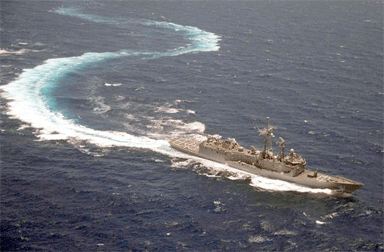Manoeuvring in Waves
Backgrounds
Manoeuvring requirements were formulated by IMO as a series of manoeuvres in calm water to ensure that the ship is able to turn and that the ship reacts to rudder action quick enough. These criteria were verified by performing turning circle and zigzag manoeuvres and checking tactical diameters and overshoot angles.
Within a manoeuvring working of NATO a series of manoeuvring requirements were formulated as a function of mission or task of that ship. For each of the missions a certain speed was defined at which manoeuvring performance has to be demonstrated. This leads to a long list of manoeuvres for a ship design with different mission profiles. The requirements are formulated in a STANAG on manoeuvring, which is expected to become active in the near future. It can be expected that some of those requirements will also hold for civilian ship regulation in the future.
Previous manoeuvring working groups have looked at manoeuvring performance in calm water only to verify the IMO criteria. A long list of ships were used to come to a Manoeuvring Prediction Program (MPP), which is able to solve several calm water manoeuvres using a time domain simulation. This program does quite a good job in predicting calm water manoeuvrability for commercial full block ships like tankers and bulkers, unfortunately the performance for modern slender naval type ships is quite poor.

Objectives
The objective of this working group is to come to a code which enables the user to predict STANAG naval ship manoeuvring criteria, hence course keeping, track keeping and astern course keeping.
Several possibilities of combining theories for low frequent manoeuvring and higher (wave) frequent ship motions will be investigated and explored. Conducting model test to elaborate the theory and expand the knowledge is part of the project. After which the theory shall be integrated in a simulation tool.
Because course keeping and track keeping will in reality be done using autopilots, this knowledge has to be put into the code as well. Furthermore knowledge on rudder control and rudder roll stabilisation will be extended and implemented in the simulation tool.
Expected Results
1. An improved version of the manoeuvring prediction program for calm water manoeuvres for slender ships.
2. Improved knowledge on the coupling between seakeeping and manoeuvring, including possibilities and impossibilities.
3. Knowledge of the effects of different autopilot models on course and track keeping.
4. A program to check the requirements stated in the STANAG, this requires a code that runs in a batch mode to calculate all manoeuvres, collect and present the results of all those manoeuvres in an overview including a pass or fail statement.
